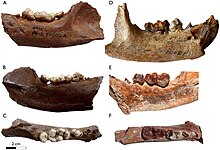| Enhydriodon Temporal range: Late Miocene to Early Pleistocene,
| |
|---|---|

| |
| Lower jaw dentitions of Enhydriodon hendeyi (A-C) and Enhydriodon africanus (D-F) | |
| Scientific classification | |
| Domain: | Eukaryota |
| Kingdom: | Animalia |
| Phylum: | Chordata |
| Class: | Mammalia |
| Order: | Carnivora |
| Family: | Mustelidae |
| Subfamily: | Lutrinae |
| Tribe: | †Enhydriodontini |
| Genus: | †Enhydriodon Falconer, 1868 |
| Type species | |
| †Enhydriodon sivalensis Falconer, 1868
| |
| Other species | |
| |
| Synonyms | |
|
Genus synonymy
Synonyms of E. sivalensis
Synonyms of E. ekecaman
| |
Enhydriodon is an extinct genus of mustelids known from Africa, Pakistan, and India that lived from the late Miocene to the early Pleistocene. It contains nine confirmed species, two debated species, and at least a few other undescribed species from Africa. The genus belongs to the tribe Enhydriodontini (which also contains Sivaonyx and Vishnuonyx) in the otter subfamily Lutrinae. Enhydriodon means "otter tooth" in Ancient Greek and is a reference to its dentition rather than to the Enhydra genus, which includes the modern sea otter and its two prehistoric relatives.
The exact sizes and lengths of Enhydriodon species are unknown given the lack of complete fossils of it and most related fossil lutrines. Indian subcontinental species are estimated to be of weights similar to that of the extant sea otter, but African species are estimated to be heavier than extant lutrines. In particular, several species such as E. kamuhangirei, E. dikikae, and E. omoensis were estimated to weigh over 100 kg (220 lb). Given these weight estimates, the three species likely reached sizes comparable to extant bears or lions, making them the largest known mustelids to exist, although a lack of complete specimens makes precise estimates impossible.
Its advanced dentition is well-known, its broad, bunodont carnassials allowing the lutrine to consume prey by crushing them rather than shearing them like the modern sea otter and unlike most other extant otters. As such, it is grouped among the bunodont otters, a categorical term referring to fossil lutrines with non-bladelike carnassials in the premolars or molars of the Miocene to Pleistocene and the sea otter of the sole extant Enhydra genus. Its I3 teeth (or third incisors) are canine-like and much larger than its other incisors (although shorter than its canines), a trait not seen in extant and extinct lutrine genera. It is hypothesized that Indian species of Enhydriodon were semiaquatic and consumed bivalves because their bunodont dentitions would have allowed them to consume hard-shelled invertebrates. It is unknown whether African species were generally aquatic, semiaquatic, or terrestrial, but their potential diets suitable for bunodont dentitions include bivalves, catfish, reptiles, eggs, and carrion. E. omoensis of Ethiopia in particular could have been a terrestrial locomotor that at least semiregularly hunted or scavenged terrestrial prey with C4 plant diets which if true makes its behaviour unlike any extant otters. It is unknown whether the species is an outlier amongst African bunodont otter species, but it has been suggested that Enhydriodon dikikae and Sivaonyx beyi were both large terrestrial bunodont otters of Africa as well.
The taxonomic status of Enhydriodon species have been complicated by its affinities and similarities with other bunodont lutrine genera like Sivaonyx and Paludolutra up to the modern day, although Paludolutra is presently considered a distinct genus not closely related to Enhydriodon. Currently, the Enhydriodontini tribe is considered evolutionarily closer to the modern Enhydra genus than any other known bunodont otter genus that may have gained bunodont dentition as a result of parallel evolution, but the extent to which they are closely related remains unresolved.
© MMXXIII Rich X Search. We shall prevail. All rights reserved. Rich X Search
